On-farm tree planting and woodland creation could be used to secure a more sustainable future through the additional income and business resilience provided by having trees, according to the latest advice from Ceres Rural.
Strategic tree planting brings both financial and environmental benefits, says Robbie Brett, farming consultant with Ceres Rural, who highlights that there’s a wide range of grants which can fund the planting and management of new woodlands.
“Woodland is long-term, so planning and management is critical,” he says. “Knowing what you want to achieve with any woodland is important too – trees can lock up carbon and support nature recovery, as well as contributing to wider society goals.
“That outcome must be agreed before you decide on the best way to fund any project – new woodland can offer much more than just carbon sequestration.”
Accessing funding
Farm businesses can access funding from the Forestry Commission, through the Woodland Trust and via Countryside Stewardship, as well as from private initiatives such as those offered by water companies.
“As well as their role in habitat creation, flood mitigation, improving water quality and reducing soil erosion, trees can be productive in terms of timber, fruit and nuts and bring in another income,” says Robbie. “They are also subject to a range of tax reliefs if the woodland is managed as a commercial investment.”
Both the Woodland Creation Planning Grant and the England Woodland Creation Offer (EWCO) can be used to plan and pay for tree planting, he adds, although the initiatives have different minimum area requirements of between 1-5ha.
“These schemes provide up to £30,000 for planning and up to £8500/ha for the creating of new woodland. Maintenance payments of £300/ha/year are included for the first 10 years of the EWCO scheme, which also allows you to apply with several parcels of woodland.”
Alternative funding
The Woodland Trust’s MOREwoods and MOREhedges schemes are alternative ways of funding new woodland and hedging, he continues.
MOREwoods covers up to 75% of planting costs and allows multiple blocks of planting, while MOREhedges subsidises hedging that creates ecological links with woodland in the surrounding landscape. “In this case, new hedging must connect with at least 0.2ha of existing or newly planted woodland, you must plant over 100m of new hedge and try to include a large tree every 6m.”
Trees can also be included within Countryside Stewardship applications, adds Robbie. “Up to £6,800/ha is available for the creation of new woodlands. Current payment rates are £1.28/tree, with some variation between native and non-native species.”
Carbon-based income
For farmers wishing to generate a carbon-based income from new woodland, it is essential to register the plantation with the Forestry Commission’s Woodland Carbon Code before planting commences, he says.
Carbon units can be sold as early as five years after planting, validating and verifying the woodland, with the Government-backed Woodland Carbon Guarantee ensuring a minimum price for carbon credits but still allowing farmers to sell them on the open market, if preferred. “Baseline your soil carbon before you start planting if you are planning to sell that as well.”
If carbon sequestration is the sole purpose of the new woodland, conifers may be the best choice as they sequester carbon more quickly, he advises. “However, they offer less in terms of improving biodiversity. A mixed planting approach is often better, as diversity is vital and broad-leaved trees sequester more carbon in the long term.”
Advice options
Seeking expert advice on the potential for tree planting and the grant opportunities is important, especially as natural capital and carbon markets are still in their infancy, concludes Robbie.
“Time spent considering the various options and the best way of achieving your end goals is a good investment. Most farms will have pockets of land suitable for tree planting and will be eligible for one of the funding schemes.”




